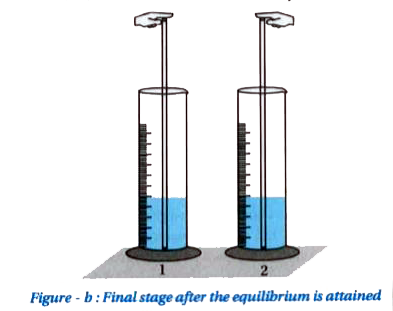Explain dynamic nature of chemical system in laboratory
Text Solution
Activity: Take two 100 mL measuring cylinders (marked as 1 and 2) and two glass tubes each of 30 cm length and same diameter and also marked 1 and 2. Fill cylinder-1 with coloured water like (potassium permanganate) solution and keep second cylinder (number-2) empty.
Put one tube in cylinder-1 and second in cylinder-2. The initial stage figure is as under.

Putting hollow tube-1 in cylinder-1 the hollow tube will fill with the coloured water. Close the upper tip and take it out from the cylinder and transfer the coloured water which is in it into cylinder-2. Repeat the process again similarly put the hollow tube in cylinder 2 and transfer the coloured water from it to cylinder-1. Transfer the coloured water from cylinder-1 to cylinder-2 do this process till the level of coloured water in both the cylinder becomes constant.
If we continue inter transferring coloured solution between the solution by the hollow tube there will not be any further change in the levels of coloured water in two cylinder.

Forward reaction: (coloured water in cylinder-1 is decrease ) (Add water in empty cylinder-2)
Reverse reaction: (Decrease water in cylinder-2 ) Add water in cylinder-1)
Equilibrium : (Coloured water in cylinder-1) (Coloured water of cylinder -2)
|
Topper's Solved these Questions
- EQUILIBRIUMBOOK - KUMAR PRAKASHANCHAPTER - EQUILIBRIUMEXERCISE - SECTION-A Try Your self -2
6 Videos
- EQUILIBRIUMBOOK - KUMAR PRAKASHANCHAPTER - EQUILIBRIUMEXERCISE - SECTION-A Try Your self -3
10 Videos
- ENVIRONMENT CHEMISTRY BOOK - KUMAR PRAKASHANCHAPTER - ENVIRONMENT CHEMISTRY EXERCISE - Question For Module (Section-C)
1 Videos
- HYDROCARBONSBOOK - KUMAR PRAKASHANCHAPTER - HYDROCARBONSEXERCISE - (Questions for Module (Section - D))
1 Videos
Similar Questions
Knowledge Check
The first Hormone chemically synthesised in the laboratory is
ACortisoneBInsulinCAdrenalineDEstroneThe national chemical laboratory is situated in?
ANew DelhiBPuneCBangaloreDPatnaAssertion: The equilibrium in physical system is also dynamic in nature.
Reason: The equilibrium ice ⇔ water is static is static in nature.AIf both assertion and reason are true and the reason is the correct explanation of the assertion.BIf both assertion and reason are true but reason is not the correct explanation of the assertion.CIf assertion is true but reason is false.DIf assertion is false but reason is true.
What is meant by business environment? Explain 'dynamic nature' and 'uncertainty as features of business environment.
View SolutionWhat is meant by dynamic nature of equilibrium?
View SolutionHow is the dynamic nature of equilibrium explained?
View SolutionWhat do you understand by the dynamic nature of equilibrium? Explain with an example.
View SolutionExplain with chemical reactions, why is zinc oxide amphoteric in nature ?
View Solution
